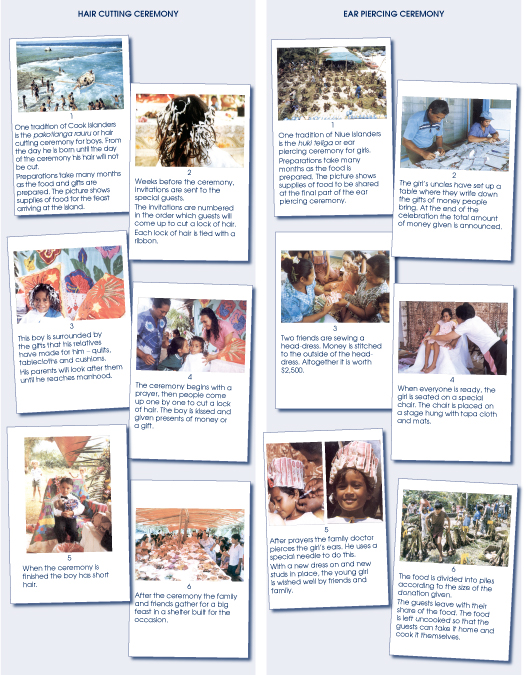|
||||||||||
|
||||||||||||||||||||||||||||||||
|
||||||||||||||||||||||||||||||||
| %
responses 2005 (01) |
||||||||||||||||||||||||||||||||
| - |
y8 |
|||||||||||||||||||||||||||||||
| 1.
Why might the ceremonies be very important for the people?
|
||||||||||||||||||||||||||||||||
| 2. What might happen if they stopped having these kinds of ceremonies? | ||||||||||||||||||||||||||||||||
| Involvement: | all
members contributed substantially |
53
(47) |
||||||||||||||||||||||||||||||
one
member did not contribute substantially |
40
(43) |
|||||||||||||||||||||||||||||||
two
or more members did not contribute substantially |
7
(10) |
|||||||||||||||||||||||||||||||
| Collaboration in decision-making: | high
level of collaboration |
38
(32) |
||||||||||||||||||||||||||||||
moderate
level of collaboration |
50
(56) |
|||||||||||||||||||||||||||||||
little
or no collaboration |
12
(12) |
|||||||||||||||||||||||||||||||
| Social environment in group: | pleasant/encouraging
for all |
88
(88) |
||||||||||||||||||||||||||||||
some
harsh moments (e.g. put downs) |
9
(12) |
|||||||||||||||||||||||||||||||
frequently
unpleasant |
3
(0) |
|||||||||||||||||||||||||||||||
| Quality
of ideas about why ceremonies are important: (tradition, recognising growth/maturity, coming of age, communal life, etc.) |
||||||||||||||||||||||||||||||||
excellent/very
good |
14
(2) |
|||||||||||||||||||||||||||||||
good
|
22
(13) |
|||||||||||||||||||||||||||||||
moderate
|
46
(63) |
|||||||||||||||||||||||||||||||
poor
|
18
(22) |
|||||||||||||||||||||||||||||||
| Key similarities between ceremonies: | long
preparation period (many months) |
31
(32) |
||||||||||||||||||||||||||||||
lots
of food prepared/brought to ceremony |
88
(72) |
|||||||||||||||||||||||||||||||
gifts
for child |
77
(87) |
|||||||||||||||||||||||||||||||
prayers
|
63
(68) |
|||||||||||||||||||||||||||||||
greetings
from guests to child |
3
(8) |
|||||||||||||||||||||||||||||||
obvious
change in appearance of child |
8
(5) |
|||||||||||||||||||||||||||||||
ceremonies
involve touching head - not normally appropriate |
0
(3) |
|||||||||||||||||||||||||||||||
both
sitting in specially decorated place |
17
(20) |
|||||||||||||||||||||||||||||||
very
significant tradition, recognition of growing up |
17
(17) |
|||||||||||||||||||||||||||||||
| Key differences between ceremonies: | gender
of child |
57
(53) |
||||||||||||||||||||||||||||||
which
feature changed (ears vs. hair) |
70
(60) |
|||||||||||||||||||||||||||||||
mention
of invitations for Cook Islands ceremony (hair) |
27
(30) |
|||||||||||||||||||||||||||||||
table
for recording money gifts (Niue
- ear piercing) |
3
(2) |
|||||||||||||||||||||||||||||||
announcement
of total money at end of Niue ceremony |
3
(7) |
|||||||||||||||||||||||||||||||
special
head-dress with attached money (Niue
- ear piercing) |
31
(42) |
|||||||||||||||||||||||||||||||
ribbons
for each lock of hair (Cook Islands) |
17
(15) |
|||||||||||||||||||||||||||||||
special
chair for girl (Niue - ear piercing) |
17
(20) |
|||||||||||||||||||||||||||||||
who
does main activity (doctor vs. guests) |
23
(17) |
|||||||||||||||||||||||||||||||
mention
that parents will look after gifts for boy until manhood |
3
(2) |
|||||||||||||||||||||||||||||||
mention
of boy being kissed |
19
(23) |
|||||||||||||||||||||||||||||||
feast
at ceremony (Cook Islands) vs. food taken away to cook (Niue)
|
33
(32) |
|||||||||||||||||||||||||||||||
special
shelter built for feast–boy |
10
(8) |
|||||||||||||||||||||||||||||||
| Overall rating for description of similarities and differences: | excellent/very
good |
3
(2) |
||||||||||||||||||||||||||||||
good
|
35
(28) |
|||||||||||||||||||||||||||||||
moderate
|
41
(47) |
|||||||||||||||||||||||||||||||
poor
|
21
(23) |
|||||||||||||||||||||||||||||||
Total
score: |
16–28
|
2
(2) |
||||||||||||||||||||||||||||||
13–15
|
14
(5) |
|||||||||||||||||||||||||||||||
10–12
|
21
(26) |
|||||||||||||||||||||||||||||||
7–9
|
35
(34) |
|||||||||||||||||||||||||||||||
4–6
|
24
(31) |
|||||||||||||||||||||||||||||||
0–3
|
4
(2) |
|||||||||||||||||||||||||||||||
Commentary: Like their year 4 counterparts in the task Birthdays, the year 8 teams generally had little difficulty identifying some similarities and some differences between the two ceremonies but were light on detail. They averaged three similarities and three differences. There was little change in performance between 2001 and 2005. |
| |
